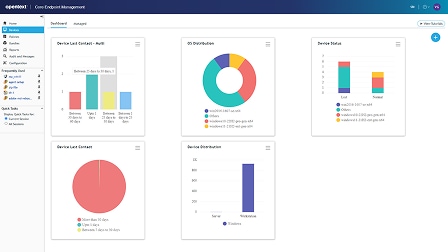Why OpenText
Why OpenText
Overview Why OpenText
OpenText brings decades of expertise to help you unlock data, connect people and processes, and fuel AI with trust
Manage and connect data
Unify data seamlessly across your enterprise to eliminate silos, improve collaboration, and reduce risks
AI-ready information
Get AI-ready and transform your data into structured, accessible, optimized information
Built-in security and compliance
Meet regulatory and compliance requirements and protect your information throughout its lifecycle
Empowering people
Overview Empowering people
OpenText helps people manage content, automate work, use AI, and collaborate to boost productivity
Customers
See how thousands of companies around the world are succeeding with innovative solutions from OpenText
Employees
Our people are our greatest asset; they are the life of the OpenText brand and values
Corporate Responsibility
Learn how we aspire to advance societal goals and accelerate positive change
Partners
Find a highly skilled OpenText partner with the right solution to enable digital transformation
How we compare
Content Management
Service Management
Deploy anywhere
Overview Deployment options
Explore scalable and flexible deployment options for global organizations of any size
Sovereign cloud
Local control. Global scale. Trusted AI
Private cloud
Your cloud, your control
On-premises
Free up resources, optimize performance and rapidly address issues
Public cloud
Run anywhere and scale globally in the public cloud of your choice
AI leadership
Overview Aviator AI
See information in new ways
OpenText™ Aviator AI
AI that understands your business, your data, and your goals
OpenText™ MyAviator
Say hello to faster decisions. Your secure personal AI assistant is ready to get to work
OpenText™ Business Network Aviator
Gain better insights with generative AI for supply chains
OpenText™ Content Aviator
Power work with AI content management and an intelligent AI content assistant
OpenText™ Cybersecurity Aviator
Improve your security posture with AI cybersecurity and agile threat detection
OpenText™ DevOps Aviator
Enable faster app delivery, development, and automated software testing
OpenText™ Experience Aviator
Elevate customer communications and experiences for customer success
OpenText™ Service Management Aviator
Empower users, service agents, and IT staff to find the answers they need
Aviator AI
Overview Aviator AI
See information in new ways
OpenText™ Aviator AI
AI that understands your business, your data, and your goals
OpenText™ MyAviator
Say hello to faster decisions. Your secure personal AI assistant is ready to get to work
OpenText™ Business Network Aviator
Gain better insights with generative AI for supply chains
OpenText™ Content Aviator
Power work with AI content management and an intelligent AI content assistant
OpenText™ Cybersecurity Aviator
Improve your security posture with AI cybersecurity and agile threat detection
OpenText™ DevOps Aviator
Enable faster app delivery, development, and automated software testing
OpenText™ Experience Aviator
Elevate customer communications and experiences for customer success
OpenText™ Service Management Aviator
Empower users, service agents, and IT staff to find the answers they need
Analytics
Overview Analytics
Predict, act, and win with real-time analytics on a smarter data platform
OpenText™ Aviator Search(AI)
Give users access to the answers they need, faster and easier, with multi-repository AI-based search that lets you contextualize everything from clicks to conversations
Business Network
Overview Business Network
Connect once, reach anything with a secure B2B integration platform
Content
Overview Content
Reimagine knowledge with AI-ready content management solutions
OpenText™ Content Aviator(AI)
Supercharge intelligent workspaces with AI to modernize work
Cybersecurity
Overview Cybersecurity
Integrated cybersecurity solutions for enterprise protection
OpenText Cybersecurity for SMBs & MSPs
Purpose built data protection and security solutions
OpenText™ Cybersecurity Aviator(AI)
Reinvent threat hunting to improve security posture with the power of agile AI
DevOps
Overview DevOps
Ship better software—faster—with AI-driven DevOps automation, testing, and quality
Experience
Overview Experience
Reimagine conversations with unforgettable customer experiences
Observability and Service Management
Overview Observability and Service Management
Get the clarity needed to cut the cost and complexity of IT operations
OpenText™ Service Management Aviator(AI)
Redefine Tier 1 business support functions with self-service capabilities from private generative AI
APIs
Overview APIs
Build custom applications using proven OpenText Information Management technology
OpenText™ Aviator Thrust
Build it your way with OpenText Cloud APIs that create the real-time information flows that enable custom applications and workflows
Device and Data Protection
Overview Device and Data Protection
Protect what matters, recover when it counts
Unified Endpoint Management Tools
- OpenText™ Endpoint Management
- OpenText™ ZENworks Suite
- OpenText™ ZENworks Service Desk
- OpenText™ ZENworks Configuration Management
- OpenText™ ZENworks Endpoint Security Management
- OpenText™ ZENworks Full Disk Encryption
- OpenText™ ZENworks Endpoint Software Patch Management
- OpenText™ ZENworks Asset Management
Solutions
Information Reimagined
Overview Information Reimagined
Get greater visibility and sharper insights from AI-driven information management. Ready to see how?
Knowledge reimagined
Transform daily work with enterprise content management powered by AI
Service Management reimagined
Cut the cost and complexity of IT service management, AIOps, and observability
Connections reimagined
AI-powered B2B integration for supply chain success
Conversations reimagined
Drive value, growth, and loyalty with connected customer experiences
Engineering reimagined
Agile development and software delivery? It only seems impossible
Security reimagined
Cybersecurity for the Enterprise
Decisions reimagined
Unlock insights with AI data analytics
Artificial Intelligence
Overview Aviator AI
See information in new ways
OpenText™ Aviator AI
AI that understands your business, your data, and your goals
OpenText™ MyAviator
Say hello to faster decisions. Your secure personal AI assistant is ready to get to work
OpenText™ Business Network Aviator
Gain better insights with generative AI for supply chains
OpenText™ Content Aviator
Power work with AI content management and an intelligent AI content assistant
OpenText™ Cybersecurity Aviator
Improve your security posture with AI cybersecurity and agile threat detection
OpenText™ DevOps Aviator
Enable faster app delivery, development, and automated software testing
OpenText™ Experience Aviator
Elevate customer communications and experiences for customer success
OpenText™ Service Management Aviator
Empower users, service agents, and IT staff to find the answers they need
Industry
Overview Industry solutions
Improve efficiency, security, and customer satisfaction with OpenText
Energy and resources
Transform energy and resources operations with cloud, cybersecurity, and AI
Financial services
Boost customer experience, compliance, and efficiency with AI
Government
Reimagine your mission with government-secure information management
Healthcare and life sciences
Improve care delivery and patient engagement with AI-powered solutions
Legal
Modernize legal teams with automated, AI-powered legal tech solutions
Manufacturing
Modernize manufacturing operations and logistics to reduce costs and ensure compliance
Retail and consumer goods
Enhance consumer engagement with omnichannel retail solutions and AI
Enterprise Application
Overview Solutions for Enterprise Applications
Run processes faster and with less risk
Services
Services
Overview Services
Achieve digital transformation with guidance from certified experts
Professional Services
Modernize your information management with certified experts
Customer Success Services
Unlock the full potential of your information management solution
Support Services
Turn support into your strategic advantage
Managed Services
Extend IT teams with certified OpenText application experts
Learning Services
Discover training options to help users of all skill levels effectively adopt and use OpenText products
Professional Services
Overview Professional Services
Modernize your information management with certified experts
Customer Success Services
Overview Customer Success Services
Unlock the full potential of your information management solution
Support Services
Overview Support Services
Turn support into your strategic advantage
Managed Services
Overview Managed Services
Extend IT teams with certified OpenText application experts
Learning Services
Overview Learning Services
Discover training options to help users of all skill levels effectively adopt and use OpenText products
Partners
Find a Partner
Overview Find a partner
Information is the heartbeat of every organization. We build information management software so you can build the future
Cloud Partners
Overview Cloud Partners
OpenText partners with leading cloud infrastructure providers to offer the flexibility to run OpenText solutions anywhere
Enterprise Application Partners
Overview Enterprise Application Partners
OpenText partners with top enterprise app providers to unlock unstructured content for better business insights
Partner Solutions
Overview Partner Solutions
Discover flexible and innovative offerings designed to add value to OpenText solutions
Resources for Partners
Overview Resources for Partners
Discover the resources available to support and grow Partner capabilities
Support
Overview Customer Support
Get expert product and service support to accelerate issue resolution and keep business flows running efficiently
Resources
Overview Resources
Explore detailed services and consulting presentations, briefs, documentation and other resources
This page is available for the following regions.
Europe, Middle East and Africa
Asia–Pacific
OpenText Endpoint Management
Enhance security and efficiency with unified endpoint management

Manage constant Windows endpoint changeRead the IDC report on UEM
Overview
Managing disparate devices across distributed workforces is time consuming and expensive. As cybersecurity challenges shift rapidly and budgets shrink, a more efficient IT management strategy is the only sustainable path.

Why OpenText Endpoint Management?
OpenText is a leader in unified endpoint management. OpenText Endpoint Management is the SaaS version of OpenText™ ZENworks unified endpoint management, a solution used by thousands of organizations globally.
- Zero touch
software deployment
Deploy new software to all Windows endpoints with a few clicks - Compliant
with company and legal regulations
Use extended inventory reports to demonstrate your Windows devices are safe and follow legal and organizational regulations - Up to date
cloud solution
Enjoy the many benefits of a cloud-based SaaS solution—including no capital expenditures
Use cases
Want to manage your Windows devices and keep them secure and compliant—without the fuss? Discover what you can do with OpenText Endpoint Management.
Simplify IT with a centralized platform that manages, monitors, and secures all Windows devices, including desktops, laptops, and server endpoints. Enhance security, streamline software distribution, ensure compliance, and support remote work scalability.
Strengthen Windows endpoint security posture through automated updates and centralized policy settings. Monitor and prove compliance through OpenText Endpoint Management inventory reports.
Base device management decisions on facts, not assumptions. Get detailed status insights on your Windows endpoints to make sure they’re safe and secure, as well as inventory reports to prove internal and external compliance.
Key features
Make IT’s life easier with feature-rich unified endpoint management.

Multi-tenant SaaS platform
Streamlines IT management of Windows devices from a single cloud application location.

Agent-based Windows device management
Simplifies Windows endpoint deployment through agent-based, extensive device management capabilities.

Application deployment for managed devices
Deploys simple to complex applications using standard application packaging. Installs and manages individual files and executes chain installations. Surfaces applications in the Start menu.

Managed device inventory collection and reporting
Creates extensive hardware and software inventories—including many details like OS version, memory, disk capacity, disk usage, peripherals, organization details and installed software.

Administrator action auditing
Tracks all or selected actions performed by OpenText Endpoint Management administrators in the management console. Automatically categorizes events by criticality, device, and administrator.
OpenText Endpoint Management resources
-
Windows unified endpoint management (UEM) is a comprehensive approach to managing and securing all Windows devices from a single console. It allows IT administrators to deploy, configure, secure, manage, and monitor Windows devices.
-
Yes, cloud-based UEM solutions manage devices regardless of location. They enable IT teams to deploy updates, enforce policies, and troubleshoot remotely through a centralized console.
-
Cloud-based Windows UEM offers several advantages. It allows for reduced on-premises infrastructure costs and maintenance. It offers seamless management of remote and distributed workforces. It provides automatic updates and feature enhancements without manual intervention.
-
Endpoint management enhances security by ensuring device health and compliance, using advanced security signals, and mitigating cyber threats. It helps protect corporate data and supports a Zero Trust security model.
-
Endpoint management improves IT efficiency by consolidating management tasks, automating updates, and providing data-driven insights. It reduces the complexity of managing multiple endpoints.
-
Cloud-based UEM typically has lower upfront costs since it eliminates the need for physical infrastructure and offers scalability for growing organizations.
OpenText Endpoint Management product overview
Read the overviewOpenText Endpoint Management product overview
Read the overview
Take the next step





